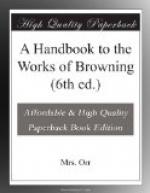The title of the book arose as follows. The narrative is addressed (as the volume is dedicated) to Miss Annie Thackeray; and its supposed occasion is that of a meeting which took place at St. Rambert—actually St. Aubin—between her and Mr. Browning, in the summer of 1872. She had laughingly called the district “White Cotton Night-Cap Country,” from its sleepy appearance, and the universal white cap of even its male inhabitants. Mr. Browning, being acquainted with the tragedy of Clairvaux, thought “Red Cotton Night-Cap Country” would be a more appropriate name; and adopted it for his story, as Miss Thackeray had adopted hers for one which she promised to write. But he represents himself as playing at first with the idea; and as leading the listener’s mind, from the suggestions of white night-caps to those of the red one: and null the outward calmness of the neighbouring country, to the tragic possibilities which that calmness conceals.
The supplementary heading, “Turf and Towers,” must have been inspired by the literal facts of the case; but it supplies an analogy for the contrasted influences which fought for Miranda’s soul. The “tower” represents the militant or religious life. The “turf,” the self-indulgent; and the figure appears and reappears at every stage of the man’s career. The attempt at compromise is symbolized by a pavilion: a structure aping solidity, but only planted on the turf. The final attempt at union is spoken of as an underground passage connecting the two, and by which the fortress may be entered instead of scaled. The difficulty of making one’s way through life amidst the ruins of old beliefs and the fanciful overgrowth in which time has clothed them; the equal danger of destroying too much and clearing away too little; also find their place in the allegory.
The possible friend and adviser, to whom Miranda is referred at vol. xii. p. 122, was M. Joseph Milsand, who always at that time passed the bathing season at St. Aubin.[80]
“THE INN ALBUM” is a tragedy in eight parts or scenes: the dialogue interspersed with description; and carried on by four persons not named. It is chiefly enacted in the parlour of a country inn; and the Inn “Album,” in spite of its grotesque or prosaic character, becomes an important instrument in it.
Four years before the tragedy occurred—so we learn from the dialogue—a gentlemanly adventurer of uncertain age had won and abused the affections of a motherless girl, whom he thought too simple to resent the treachery. He was mistaken in this; for her nature was as proud as it was confiding; and her indignation when she learned that he had not intended marriage was such as to surprise him into offering it. She rejected the offer with contempt. He went his way, mortified and embittered. A month later she had buried herself in a secluded and squalid village, as wife of the old, poor, overworked, and hopelessly narrow-minded clergyman, whose cure it was. She abstained, however, for his own sake, from making any painful disclosures to her husband; and the daily and hourly expiation brought no peace with it; for she remained in her deceiver’s power.




